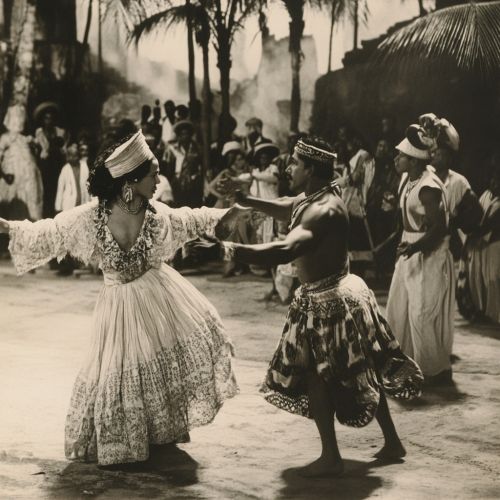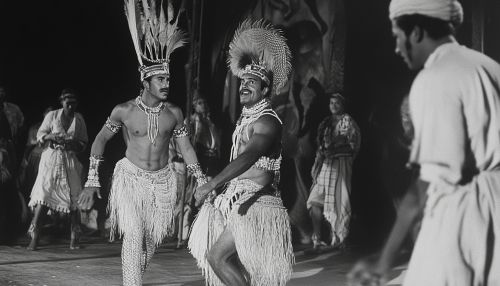Brazilian cinema: Difference between revisions
No edit summary |
No edit summary |
||
| Line 3: | Line 3: | ||
Brazilian cinema, also known as cinema brasileiro, encompasses the film industry and film production in Brazil. It is characterized by a rich and diverse history that reflects the country's complex social, cultural, and political landscape. This article delves into the origins, evolution, key movements, notable filmmakers, and contemporary trends in Brazilian cinema. | Brazilian cinema, also known as cinema brasileiro, encompasses the film industry and film production in Brazil. It is characterized by a rich and diverse history that reflects the country's complex social, cultural, and political landscape. This article delves into the origins, evolution, key movements, notable filmmakers, and contemporary trends in Brazilian cinema. | ||
[[Image:Detail-98039.jpg|thumb|center|Scene from a classic Brazilian film, showing actors in traditional attire performing a dramatic scene.]] | [[Image:Detail-98039.jpg|thumb|center|Scene from a classic Brazilian film, showing actors in traditional attire performing a dramatic scene.|class=only_on_mobile]] | ||
[[Image:Detail-98040.jpg|thumb|center|Scene from a classic Brazilian film, showing actors in traditional attire performing a dramatic scene.|class=only_on_desktop]] | |||
=== Origins and Early Developments === | === Origins and Early Developments === | ||
Latest revision as of 15:34, 20 September 2024
Brazilian Cinema
Brazilian cinema, also known as cinema brasileiro, encompasses the film industry and film production in Brazil. It is characterized by a rich and diverse history that reflects the country's complex social, cultural, and political landscape. This article delves into the origins, evolution, key movements, notable filmmakers, and contemporary trends in Brazilian cinema.


Origins and Early Developments
The history of Brazilian cinema dates back to the late 19th century, shortly after the invention of the cinematograph by the Lumière brothers. The first film screening in Brazil took place in Rio de Janeiro in 1896, marking the beginning of the nation's engagement with the new medium. Early Brazilian filmmakers, such as Afonso Segreto, who is credited with shooting the first Brazilian film in 1898, played a pivotal role in the nascent industry.
During the silent film era, Brazilian cinema was heavily influenced by European and American films. However, local filmmakers began to explore themes and narratives that resonated with Brazilian audiences. The 1920s saw the emergence of regional film production centers, particularly in São Paulo and Rio de Janeiro, which laid the groundwork for the future growth of the industry.
The Chanchada Era
The 1930s and 1940s witnessed the rise of the chanchada, a genre of musical comedies that became immensely popular among Brazilian audiences. Chanchadas were characterized by their light-hearted, humorous plots, often featuring musical numbers and dance sequences. The genre was dominated by studios such as Cinelândia and Atlântida Cinematográfica, which produced numerous successful films during this period.
Notable figures in the chanchada era included actors like Grande Otelo and Oscarito, who became household names. The chanchada films provided escapism during a time of political and economic turmoil in Brazil, and they played a crucial role in shaping the early identity of Brazilian cinema.
Cinema Novo
The 1960s marked a significant turning point in Brazilian cinema with the advent of the Cinema Novo movement. Influenced by Italian neorealism and the French New Wave, Cinema Novo sought to address social and political issues through a more realistic and critical lens. Filmmakers associated with this movement aimed to depict the harsh realities of Brazilian life, particularly the struggles of the poor and marginalized.
Key figures in Cinema Novo included Glauber Rocha, Nelson Pereira dos Santos, and Ruy Guerra. Rocha's film "Black God, White Devil" (1964) and Pereira dos Santos' "Barren Lives" (1963) are seminal works that exemplify the movement's aesthetic and thematic concerns. Cinema Novo had a profound impact on Brazilian cinema, inspiring subsequent generations of filmmakers to engage with social and political themes.
The Embrafilme Era
In the 1970s and 1980s, the Brazilian government established Embrafilme, a state-owned film production and distribution company, to support the national film industry. Embrafilme played a crucial role in financing and promoting Brazilian films, leading to a period of increased production and international recognition.
During this era, Brazilian cinema produced several critically acclaimed films, such as Hector Babenco's "Pixote" (1981) and Carlos Diegues' "Bye Bye Brazil" (1980). These films continued the tradition of addressing social issues while also exploring new genres and styles. However, the reliance on state funding also led to challenges, as political and economic instability affected the sustainability of the industry.
The Retomada
The 1990s saw the resurgence of Brazilian cinema, known as the Retomada (Resurgence), following a period of decline in the late 1980s. This revival was marked by the success of films such as Walter Salles' "Central Station" (1998) and Fernando Meirelles' "City of God" (2002). These films achieved both critical acclaim and commercial success, garnering international awards and recognition.
The Retomada period was characterized by a renewed focus on high-quality storytelling, technical excellence, and diverse narratives. Filmmakers explored a wide range of genres, from drama and comedy to action and thriller, reflecting the evolving tastes of Brazilian audiences and the global film market.
Contemporary Brazilian Cinema
In the 21st century, Brazilian cinema continues to thrive, with a new generation of filmmakers pushing the boundaries of the medium. Contemporary Brazilian films often address contemporary social issues, such as urban violence, racial inequality, and LGBTQ+ rights, while also experimenting with innovative storytelling techniques and visual styles.
Notable contemporary filmmakers include Kleber Mendonça Filho, whose films "Neighboring Sounds" (2012) and "Aquarius" (2016) have received international acclaim, and Anna Muylaert, known for "The Second Mother" (2015). The Brazilian film industry has also embraced digital technology, leading to increased accessibility and distribution of films both domestically and internationally.
Key Movements and Genres
Brazilian cinema has been shaped by various movements and genres over the years. In addition to Cinema Novo and chanchada, other significant movements include the Cinema Marginal of the late 1960s and early 1970s, which was characterized by its avant-garde and experimental approach, and the Tropicalismo movement, which blended elements of traditional Brazilian culture with modernist influences.
Genres such as documentary, horror, and animation have also gained prominence in Brazilian cinema. Documentaries like "Bus 174" (2002) by José Padilha and "Waste Land" (2010) by Lucy Walker have garnered international attention for their compelling storytelling and social relevance. The horror genre has seen a resurgence with films like "Good Manners" (2017) by Juliana Rojas and Marco Dutra, while Brazilian animation has produced notable works such as "The Boy and the World" (2013) by Alê Abreu.
Notable Filmmakers
Brazilian cinema has produced numerous influential filmmakers who have left a lasting impact on the industry. Some of the most notable include:
- Glauber Rocha: A leading figure in Cinema Novo, known for his politically charged films and innovative techniques.
- Nelson Pereira dos Santos: A pioneer of Cinema Novo, whose works often focused on social issues and rural life.
- Hector Babenco: An acclaimed director known for his powerful dramas, including "Pixote" and "Kiss of the Spider Woman" (1985).
- Walter Salles: A prominent filmmaker of the Retomada period, recognized for films like "Central Station" and "The Motorcycle Diaries" (2004).
- Fernando Meirelles: Director of the internationally acclaimed "City of God" and "The Constant Gardener" (2005).
Challenges and Opportunities
Despite its successes, Brazilian cinema faces several challenges, including limited funding, competition from Hollywood, and political and economic instability. However, the industry also has significant opportunities for growth, particularly with the rise of streaming platforms and digital distribution, which have expanded the reach of Brazilian films to global audiences.
Government initiatives, such as tax incentives and funding programs, continue to play a crucial role in supporting the industry. Additionally, international co-productions and collaborations have opened new avenues for Brazilian filmmakers to showcase their work on the world stage.
Conclusion
Brazilian cinema is a dynamic and evolving industry that reflects the rich cultural tapestry of the nation. From its early beginnings to the contemporary era, Brazilian filmmakers have consistently pushed the boundaries of the medium, addressing social issues, experimenting with new styles, and achieving international recognition. As the industry continues to navigate challenges and embrace new opportunities, Brazilian cinema remains a vital and influential force in the global film landscape.
